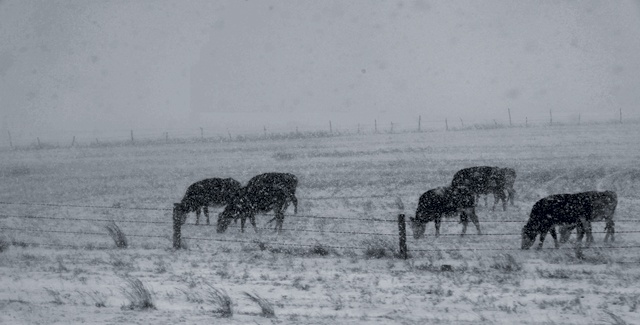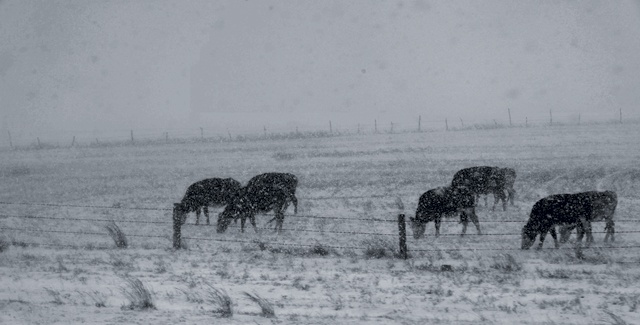When barbed wire was introduced in 1875, Texans were unimpressed. The contrivance had originated in the north, and many folks considered it a gimmick of carpetbaggery.
Barbed wire was eventually used in isolated applications, and it quickly proved durable and cost-effective. Traditional fencing materials such as timber and stone were hard to come by in many parts of the state, and barbed wire was practical. This made it an irrepressible prospect.
In no time, larger ranches purchased barbed wire by the trainload and subjugated horizon-to-horizon stretches of the Texas frontier with little regard for convenience, public access or the property of others. Barbed wire installers fenced in property that didn’t belong to them, restricting access to community water sources, obstructing cattle drives, blocking common thoroughfares and impeding postal routes. Concerned parties contacted their state legislators, but at first complaints were ignored or received unsatisfying answers.
By the late 1870s, disgruntled Texans were taking matters into their own hands. They began carrying fence-cutting pliers and simply snipping stretches of barbed wire that were in their way. As their numbers grew, fence cutters organized clandestine groups with official and unofficial names, such as the owls and the javelinas, and began cutting miles of fencing at night. If fence lines reappeared, the fence cutters nipped them again.
With no small amount of public support, the fence-cutting crusade evolved into what became known as the fence-cutters war. In many cases, fence-cutting activities were well-organized, including the use of disguises and armed lookouts to protect participants.
In 1883, the imbroglio reached a boiling point when Texas suffered through a horrendous drought. Cattle died in droves on the dwindling open ranges. The lack of access to fenced-off range was catastrophic for landless stockmen. Even some closed-range ranch advocates grazed their cattle on common ranges until the grass was gone and then moved stock into their enclosed pastures. This exacerbated the situation, increasing fence cutting, pasture-burning and sizable herd liberations, if not outright theft.
Closed-range ranchers began hiring security personnel to patrol their fencing. One large ranch in DeWitt County persuaded some Texas Rangers to trade in their tin stars for fence security work, and confrontations along the barbed-wire boundaries increased, resulting in several casualties.
By late 1883, newspapers reported that losses from destroyed fencing had reached $20 million, and tax valuations in general had declined by approximately $30 million. These staggering numbers began to shift Texans’ worldview. In the beginning, the widespread fence-cutting movement was viewed as reasonable civil disobedience. Yet, like many protest efforts that were committed to addressing inequities, fence-cutting activities devolved into petty or pointless swipes that approached vandalism, anarchy or counter-opportunism instead of redress.
With public opinion starting to favor permanent ranches, Texas politicians got involved. On October 15, 1883, Gov. John Ireland scheduled a special session of the Texas Legislature on January 8, 1884, “to consider and find remedy for wanton destruction of fences … .”
After weeks of heated debate, the special session adjourned with new laws on the books. Fencing the land of another became a misdemeanor with a fine not to exceed $200, and the culprits were granted six months to remove the illegal fence. If the fence ran across public roads, fencers were required to install a gate every 3 miles and ensure that gates were kept in working order.
Injuring a fence or leaving a fence gate open—causing “any hogs, cattle, mules, horses or other stock to go within the inclosed lands” and graze without the consent of the owner—led to a fine of $10 to $100 and imprisonment for up to one year, according to the Texas Penal Code. Willfully cutting a fence was a felony and led to imprisonment of one to five years. Pasture burning, also deemed a felony, resulted in two- to five-year imprisonment.
Enforcement of the laws reduced fence-cutting offenses, but they didn’t end altogether. Contrarian sentiment was slow to fade.
In the summer of 1888, fence cutting became a regular occurrence in Navarro County, and the Texas Rangers dispatched Sgt. Ira Aten and lawman James King to address it. Aten and King posed as farmhands and became familiar with the local fence cutters. Rather than arrest them, the duo attempted to exact their own justice on the cutters. As Aten later noted in his 1945 book “Memoirs,” he planted along fences dynamite charges rigged to explode when the wire was cut.
When Aten’s superiors got wind of his plan, he was ordered to stand down and return to Austin. Instead, he detonated the makeshift bombs in place. Rumors of remaining fence-line explosives were enough to eliminate fence cutting in the area.
Barbed wire protected pastures and reduced rustling, but it also restricted the long-held practice of free grazing and, essentially, ended large cattle drives. Then, easy access to railroad cattle cars made long-range drives and their cowboys obsolete. Within a decade, the days of the traditional cowboy in Texas were done. Frontier purists were forced to head south to Mexico or west for refuge in the remaining expanses of open American range.
Cowboys were not the only victims. Their bovine charges also suffered, especially in what came to be known as the Big Die-Up.
During the 1880s, the Texas Panhandle and the South Plains of West Texas got a little too crowded with ranches and livestock. Because the region was vulnerable to powerful blue northers—frigid storm systems that dropped temperatures rapidly, brought hard freezes and created blizzards—cattle there liked to drift far south to take cover in draws, canyons and river valleys. Every time a norther blew through, the cattle dispersed, and the ranchers had a hard time regrouping their herds.
In 1882, with barbed wire all the rage, the Panhandle Stock Association resolved to build a “drift” fence to keep northern livestock from wandering down to the southern ranges. Within a few years, the fence stretched the entire width of the Panhandle, from New Mexico to Oklahoma.
In 1885, extreme cold sent thousands of head south, and they became trapped at this fence. The cattle converged at the barrier in increasing numbers. Those not trampled, frozen or starved to death fell easy prey to wolves and coyotes. The first thaw of January 1886 revealed a barbed-wire deathtrap. Thousands of cattle lay dead along the fence line, and several big-ranch herds were almost destroyed.
Legendary Seven K Ranch foreman Frank Biggers was so incensed by the unnecessary losses that he demanded the Seven K Ranch owners allow him to cut the Panhandle fence, but they refused. Biggers immediately quit and wired his resignation from the location of his new employer, the Box T Ranch.
The 1886-87 winter brought more northers, and cattle once again perished by the thousands. One ranch hand reportedly skinned 250 carcasses a mile for approximately 35 miles along one stretch of drift fence, according to the Texas State Historical Association, and several Panhandle ranches almost went under. Within a generation or two, Panhandle cattle developed more sedentary habits and settled into a driftless existence.
The fence cutters won a few battles but lost the war. Their enemy turned out to be progress rather than carpetbaggers or big ranches.
——————–
E.R. Bills is a writer from Aledo. His book ‘Texas Obscurities: Stories of the Peculiar, Exceptional and Nefarious’ (History Press, 2013) is available at retail stores and online.




